All about Herbs
All about Herbs
-
A
-
Anise (Pimpinella anisum)
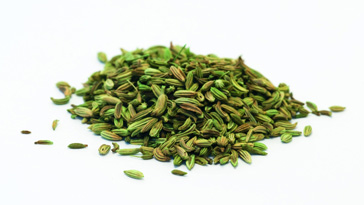
Anise tastes like summer and the Mediterranean Sea, like Pastis, Raki, Ouzo - and liquorice. The young leaves give field green salads a slightly sweet flavour, the blossoms are a pretty and edible garnish. The seeds are harvested when they have turned brown and are used for baking, in soups and sauces and above all in curry dishes - either freshly ground or whole. They are also a perfectly harmonious complement to all legumes.
-
-
B
-
Basil (Ocimum basilicum)
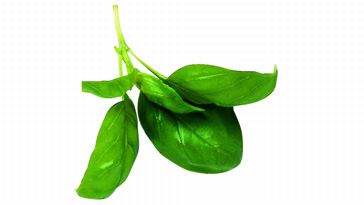
Originally from the tropics in Africa and Asia, this "king of herbs" has long since conquered the kitchens of the world. Among the 150 varieties, the annual common basil plant, which can also be grown in a pot on the sunny windowsill, is the most prevalent. Its leaves with their pleasant sweet-spicy scent are a popular seasoning for pizzas and pasta. The fresh chopped leaves add flavour to sauces and salads, soups, meat, fish and vegetable dishes, but also find use in ice cream, sorbets, fruit salads and sweets. Fresh basil loses much of its flavour during cooking; therefore, add plenty for cooking or use shortly before serving.
-
Bay Laurel (Laurus nobilis)
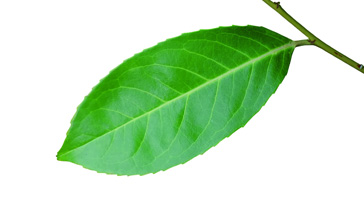
The evergreen leaves of the laurel adorned the heads of the Greek Olympian athletes. The shiny, dark green, pungent leaves add a strong flavour, fresh more so then dried. For this reason, they should be used sparingly. Bay leaves are a consistent component of the Bouquet garni, simmer in stocks, soups and sauces, accompany roasts and stews (goulash) and harmonise well with wild game and cabbage dishes (red cabbage, sauerkraut). The leaves should be removed before serving as they taste extremely bitter. Only few of the approximately 2500 species of the laurel family are as flavourful as the Laurus nobilis, which grows in the Mediterranean region as a shrub or tree. Tip: A bay leaf in stored rice, flour and cereal keeps vermin away.
-
Bishop's Weed (Aegopodium podagraria)
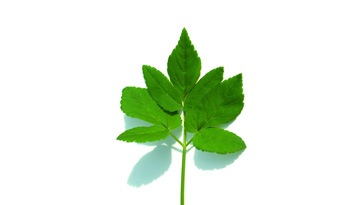
Bishop's weed is seen by many as a mere stubborn garden weed; however, the umbellifer, whose young leaves in March and April taste like carrots and celery, can be used in a variety of ways. The leaves season vegetables, soups and sauces, harmonise very well with potatoes as a stand-alone vegetable, and are the perfect topping for a piece of bread with butter. The young stems can also be prepared as a vegetable, the blossoms (June to August) are a pretty and edible decor, and the egg-shaped fruit, similar to caraway, adds a hearty twist to soups and stews.
-
Black Mustard (Brassica nigra)
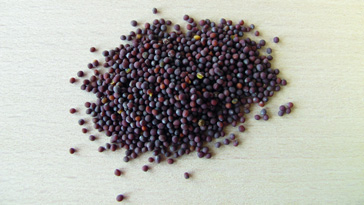
Black mustard grows all over Europe and North Africa along paths and edges of fields. The delicate leaves can be harvested in July and August and are used as a seasoning similar to cress e. example, in curd or salad. Beginning in September, the dried, ground or whole black grains make their spicy contribution to mustard and spice mixtures, pickled cucumbers and pumpkins, as well as meat marinades.
-
Black Pepper (Piper nigrum)
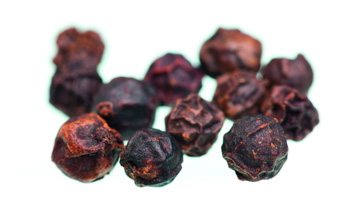
Black pepper is the fruit of the tree with the same name. It is gained from fruit that is unripe (green) until it is almost ripe (yellow-orange); shrivels and turns black when dried. It has a biting, sharp. slightly nutty flavour and is the most widely used type of pepper. It is used in almost every cuisine throughout the world and should ideally be ground just prior to use. Whole peppercorns can be used in stocks, soups and marinades.
-
Borage (Borago officinalis)
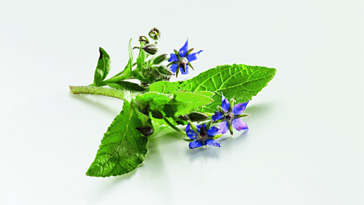
Borage tastes slightly tart and refreshing like cucumber. The delicate leaves are the most delicious; the older, tougher leaves have more of a strong taste. Borage is well suited to cream cheese and quark, egg dishes and (cucumber) salad, but also as a seasoning in spinach and cabbage. The small, edible violet-blue blossoms make a pretty garnish for desserts, salads and in refreshing cold drinks. They can also be frozen inside ice cubes.
-
Brazilian Pepper (Schinus terebinthifolius)
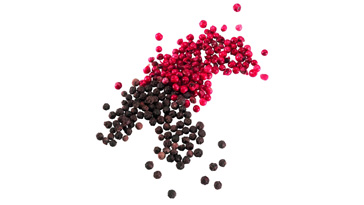
Brazilian pepper, also called Christmas berry, is a fruit of the Brazilian pepper tree, which is native to Middle and South America. It belongs to the sumac family and has nothing in common with black pepper. Brazilian pepper is slightly hot and somewhat sweet, but also has plenty of floral and fruity notes that are reminiscent of juniper. The feather-light, dried pink to red berries - when freshly ground - are well suited for fish, curry dishes and some vegetables, e. example, asparagus.
-
Burnet (Sanguisorba minor)
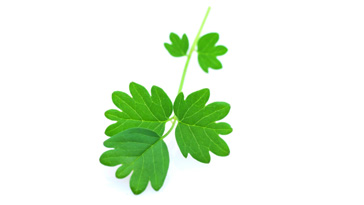
Burnet, also called salad burnet, belongs to the rosaceae family and is an essential component of the Frankfurt green sauce. The young shoots and leaves have a refreshing taste reminiscent of cucumbers. They should be used fresh as they lose their flavour quickly when dried. Burnet goes well with fresh leafy greens, light sauces and vegetable soups, but is also a tasty base for herbed lemonades.
-
-
C
-
Capers (Capparis spinosa)
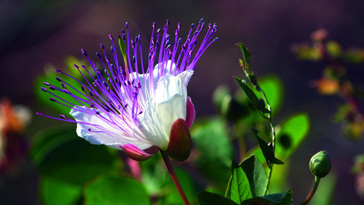
Capers are the pickled flower buds of the genuine caper bush, which is native to southern Europe and the entire Mediterranean region. The closed buds are harvested by hand in spring and are not edible in their raw state. At first they are dried for one day and then pickled in coarse sea salt, brine, vinegar or oil, which gives them their spicy-tangy flavour. The smallest capers taste the best.
-
Caraway (Carum carvi)
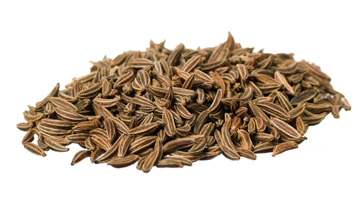
In the kitchen caraway is a true jack of all trades: During the first year, the leaves and young shoots are used in salads, soups and sauces; during the second year, the blossoms are used (as edible decorations and in salads) as well as the ripe, dried seeds - in roasted potatoes, breads, meat dishes and, above all, in cabbage dishes, which are made more easily digestible by their addition. Caraway seeds, like the seeds of anise and fennel, make a good between-meals snack. Beginning in September, the roots are a flavourful spice for soups and stews.
-
Cardamom (Elettaria cardamomum)
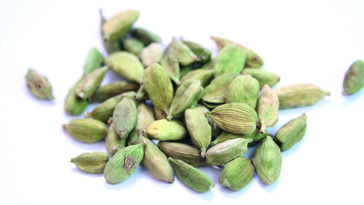
Without this spice, which belongs to the ginger family, there would be no curry, and some sweet dishes would be bland without the lemon and cinnamon flavour of cardamom. Cardamom was an expensive imported good for the ancient Greeks, and the Romans also cherished the flavour of this plant, which is native to Sri Lanka. Whereas the black seeds in the triangular capsule are used for almost every curry in the Far East, they are used to infuse flavour into coffee in the Arabian countries. In the Scandinavian countries, cardamom is not only used to add flavour to cookies and sweet breads, but also to pasties and sausages. Prior to use, always roast cardamom in a coated pan without oil until the aroma develops; then grind in a mortar.
-
Cayenne Pepper (Capsicum annuum var. acuminatum)
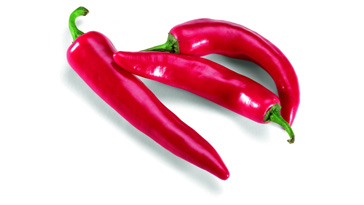
Cayenne pepper is made from the dried, ground chilli peppers of the "cayenne" variety. Thus, from a botanical perspective, it is not really pepper but a capsicum variety. As the separating walls and seeds are also included in processing, cayenne pepper is significantly hotter than black pepper and is accompanied by a slightly fruity, smoky and bitter flavour. Originally at home in Latin America, the "Spanish pepper" was brought to Europe and Asia by Spanish and Portuguese seafarers.
-
Chervil (Anthriscus cerefolium ssp. cerefolium)
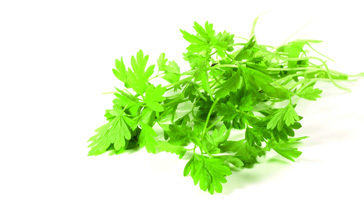
Chervil is also called pot herb in colloquial language, even though the triple and quadruple pinnate light green leaves add a wonderful taste to light sauces and curd as well. Its flavour, which is as delicate as fennel, subtle as anise and reminiscent of liquorice, is a wonderful complement to every salad, grilled fish, potato and mushroom dishes. Even a solo appearance in a cream soup is outstanding. Like parsley, the up to 60 cm tall chervil belongs to the family of umbellifers. In a flower pot on your kitchen windowsill it is available all year round. The annual chervil leaves should be harvested before the plant blooms, always added to dishes at the end and never be cooked.
-
Chilli (Capsicum annuum)
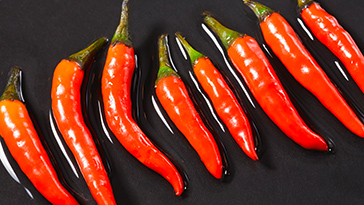
Chilli, also called peperoni, peperoncini or jalapeño pepper, belongs to the capsicum species. Because of their shape, they are often called pods, but from a botanical perspective they are berries. The colour spectrum of chillies ranges from green (unripe) to yellow, orange and red to dark red and purple. Their shape can be oblong, straight or curved as well as round. In general, this is true: The smaller and darker the fruits, the hotter their taste. The fruits are used fresh as well as dried. Removal of the light separation walls and seeds makes chillies milder.
-
Chives (Allium schoenoprasum var. schoenoprasum)
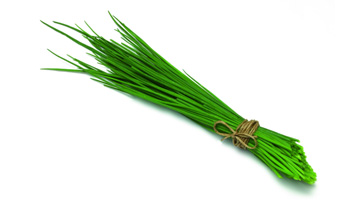
Whether in salad, soups, sauces, poultry or egg dishes, chives always provide hearty freshness and a decorative appearance. Chives belong to the bulbous plants - and you can taste that. The high, one to five millimetre thin hollow stems grow year round in gardens or pots on balconies or windowsills. Always cut chives right before use; great with fresh leafy salads, on top of egg dishes, in soups and creamy sauces. Never cook chives as heat destroys their flavour. The blossoms can be used for decoration or for seasoning. If the blossom buds are cut off regularly, the stems remain delicate and luscious. If the plants are allowed to bloom, the hollow stems will taste more hearty and earthy. Chives cannot be dried; therefore, cut the fresh stems into small pieces and freeze.
-
Cinnamon (Cinnamomum verum J. S. Presl)

Cinnamon is gained from the dried bark of cinnamon trees, particularly the genuine or Ceylon cinnamon tree. It is one of the oldest spices and was used in China as early as 3000 years before our calculation of time. Cinnamon sticks are crumbled before use, roasted in a pan without fat until they begin to release their aroma, and then pulverised. They are used to season sweet dishes, baked goods, cocoa and mulled wine but also dark sauces that accompany wild game dishes.
-
Cloves (Syzygium aromaticum)
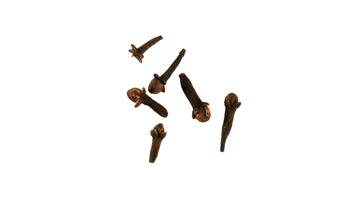
Cloves are the strongly scented and stingingly spicy tasting flower buds of the clove tree, originally from the Molucca Islands. They are also now grown in Zanzibar and Madagascar. Carefully dosed - they add spice to marinades, sauces, soups, stocks, sausages, meat and fish dishes, lebkuchen, curry dishes and of course Glühwein [mulled wine] and punch. Only the head should be used, the stem tastes bitter.
-
Coriander (Coriandrum sativum)

Equally at home in the Arab and Asian cuisine, coriander is becoming more popular in European dishes. Connoisseurs cherish the spicy-fresh, slightly sweet flavour of coriander greens and their unmistakable aroma that reminds of flat leaf parsley, anise, mint and citrus peels. The aromatic, fresh green leaves and young stems, but also the white blossoms and small, spicy-sweet smelling fruit are an essential component of many curry mixtures, give sauces and marinades a special note, and serve as a spice for canning of pickles and pumpkin. Coriander greens are used like parsley; however, the delicate, finely cut stems which intensify the flavour can also be used.
-
Curry Leaves (Murraya koenigii)

Curry leaves have their home in Southeast Asia, but also like to be grown in pots on sunny balconies and terraces in Europe. The shiny green leaves of the shrub that grows up to two metres tall emit an intense scent of curry-spice mixtures on mere touch. The dried leaves quickly lose their flavour. Curry leaves add spice to Asian dishes, meat, fish, vegetables and chutneys.
-
-
D
-
Dill (Anethum graveolens var. hortorum)

The "cucumber herb" has its origin in central Asia, but is an important component of Northern and Eastern European cuisine today. This unassuming plant, which grows up to 1.25 m tall, belongs to the family of the umbellifers. Its leaves, blossoms and the dried fruits, which taste sweet and aromatic, somewhat like anise but also like caraway, are used for cooking. The leaves and blossoms should always be used fresh for salads (cucumbers!) and sauces, but also make a great addition for potatoes and fish. The fruit and the still closed buds of the blossoms add the final kick to pickled cucumbers and vegetables as well as aromatic vinegar. They are also good in bread and rolls.
-
-
F
-
Fenugreek Seeds (Trigonella foenum-graecum)
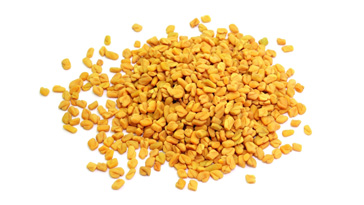
Fenugreek seeds are an aromatic component of each curry mixture. The hard, square ochre to sand coloured seeds - when freshly ground - have an intense, warm, curry-like aroma. Fenugreek, with its origin in Persia, belongs to the family of legumes and was used by the ancient Egyptians as a spice and medical remedy and has propagated all the way to Southwest Asia. Prior to its use, fenugreek should be briefly roasted in a pan without oil and then ground in a mortar.
-
Fennel (Foeniculum vulgare var. dulce)
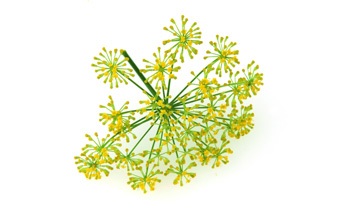
Even though fennel is a typical summer plant, its dried seeds are inextricably linked with Christmas baking. The fresh green, slender, slightly sweet leaves go well with leafy green salads, light sauces and especially fish. The seeds, which are harvested in September/October - used ground or whole - provide breads, soups and especially stews with a special kick and also promote digestion.
-
-
G
-
Garlic (Allium sativum)
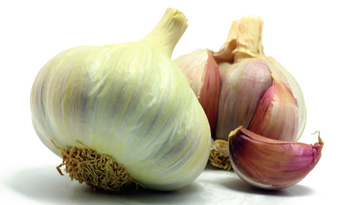
Tastes divide over garlic. Some love it, others hate it - perhaps because they have never eaten really fresh garlic. The clove, which belongs to the bulbous plants, reached Europe in ancient times from the steppes of central and southern Asia via the Mediterranean Sea. Garlic is used in warm or cold cuisine to add seasoning and provides every dish with its typical flavour that is not easily mistaken. When roasting it, it must not become too brown or it will taste bitter.
-
Ginger (Zingiber officinale)

The aromatic multi-talent is native to the warm and humid tropical jungle of South Asia. In the kitchen, the beige coloured bulb adds flavour to meat, fish, chicken, soups, salads and curries. The sweet-spicy, hearty flavour also unfolds a wonderful taste in sweet dishes such as milk rice, fruit salad, baked goods (lebkuchen), tea and beverages (ginger ale). The Japanese savour sour pickled ginger with sushi. Ginger should be stored in a dry and cool place. Cut ginger roots are best left to dry at the cut surface and then placed into the vegetable bin of the refrigerator. Freshly grated or chopped ginger can be frozen without problems and will keep for several months.
-
-
H
-
Horseradish (Amoracia rusticana)
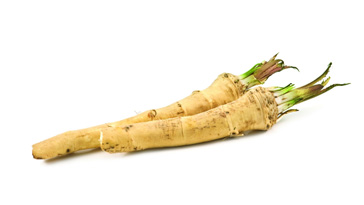
Horseradish, also called "farmers mustard" and Kren in Austria, with its hearty pepperiness is well suited for cooked meat (Tafelspitz [boiled beef]), fish, eggs and raw vegetables salads (e. example, with red beets). When mixed with curd, the fresh, peeled and finely chopped or grated roots make a delicious sandwich spread. Horseradish roots can be harvested from unfrozen soil all year round.
-
Hyssop (Hyssopus officinalis)
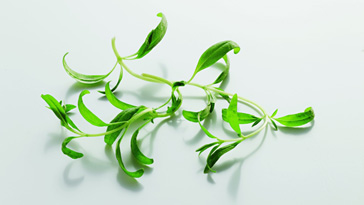
Hyssop has disappeared from view somewhat, even though the young shoots, the slightly bitter leaves and the purple, pink or white blossoms (in July and August) season fatty roasts in the most delicious way. They are also well suited for vegetables such a beans, for soups, salads and stews. Hyssop should always be used fresh, since it loses all its flavour when dried. The name, by the way, comes from the Arabic language and means "holy herb". Hyssop has been cultivated as a spice and healing plant since the 16th century.
-
-
K
-
Kaffir Lime Leaves (Citrus hystrix)

Kaffir lime leaves originate from the tree with the same name, which belongs to the citrus family. The leaves have a very intense, zesty, lemon-like and bitter flavour. They play an important role in the cuisine of Southeast Asia (Thailand, Cambodia, Malaysia and Indonesia) and of the French overseas department La Réunion. Similar to European bay leaves, the fresh or dried leaves are added when cooking sauces, soups and stews and removed before serving.
-
-
L
-
Lemongrass (Cymbopogon citratus)
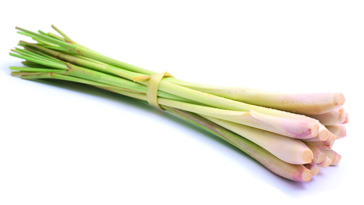
Almost no other spice is as characteristic of the Asian cuisine as the citrus-like, strong flavour of the crisp lemongrass leaves. Originating in East India, the grasses that reach up to two metres tall are now grown in all tropical regions of Asia. Lemongrass tastes best when freshly cut and is a good complement to poultry, fish and seafood, sauces and marinades. It harmonises best with coriander greens, shallots and garlic.
-
Lemon Balm (Melissa officinalis)
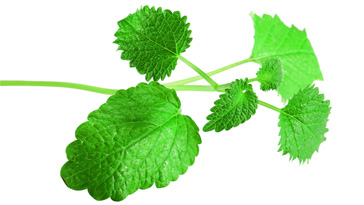
Lemon balm is native to the eastern Mediterranean region, and its fresh, finely cut leaves provide many dishes with a fresh, lemony taste. It harmonises with fish, poultry and salads, but also with fruits such as apples, strawberries and melons. It adds a fresh, herb-like note to dishes in which lemon juice is used. As an ice cold tea, lemon balm is a wonderful summer refreshment. Because it is rich in nectar, the blossom of the lemon balm is favoured by bees.
-
Lovage (Levisticum officinale)
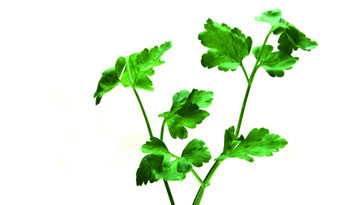
Lovage is not also called Maggi herb by accident (even though it is not contained in the liquid seasoning). It jazzes up every meat and vegetable broth with its celery-like taste. The fresh leaves have the most intense flavour; the dry leaves quickly lose their flavour, but can be frozen. Lovage harmonises perfectly with hearty, warm (potato)soups and stews, but can also be used in salads - in small amounts.
-
-
M
-
Marjoram (Origanum majorana)
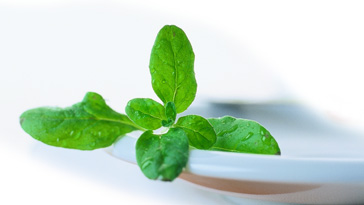
Marjoram is a typical Mediterranean spice, even though it is prevalent all the way to the Himalayas. Marjoram has an aromatic, hearty and somewhat citrusy-flowery scent and a warm, but not burning taste. The leaves are used fresh or dried to season potato dishes, soups, sauces, sausages (therefore also called "sausage herb") and legumes. Marjoram blends well with pepper, nutmeg and (particularly for venison dishes) with juniper berries.
-
Mugwort (Artemesia vulgaris)
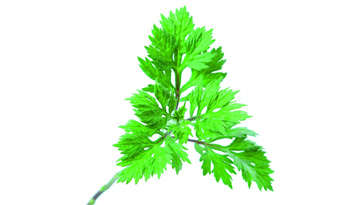
In Germany, mugwort is also called "Besenkraut" [broom herb] and "Gänsekraut" [goose herb] because the branches, which can be up to two meters tall, were used for sweeping, and because the fresh or dried shoots with the still closed buds add a slightly bitter zest to fatty foods like pork or goose. The bitter substances in it also stimulate the production of gastric juices and bile and thereby promote digestion.
-
-
N
-
Nutmeg (Myristica fragrans)
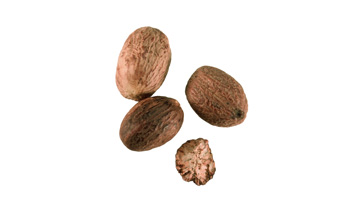
Nutmeg is the rock-hard, berry-like fruit of the tree with the same name. With its origin in the Indonesian Banda Islands and the northern Molucca Islands, it is also cultivated today in tropical Asia, in Africa, South America and Grenada. In the culinary world freshly grated nutmeg is used for seasoning potato dishes, soups and stews, meat patties and pork roast. It also adds subtle spice to cauliflower, spinach, Brussel sprouts, kohlrabi, red cabbage and parsnips.
-
-
O
-
Oregano (Origanum vulgare)

Whether fresh or dried - no other spice is connected as closely to Mediterranean dishes as wild marjoram. About 40 different kinds grow in the Mediterranean region as well as in Asia Minor and West Asia. Oregano is one of the few herbs that often have a more intense taste when dried than when freshly picked. The leaves and shoots are used, but the blossoms are also edible and are suitable for garnish. Oregano refines the taste of tomato sauces, grilled vegetables and meat, but should also be an ingredient of every good pizza and chili con carne. Oregano blends well with pickled olives, lovage leaves, capers and feta, but should always be used with caution because its intense flavour quickly covers the taste of other ingredients.
-
-
P
-
Parsley (Petroselinum crispum)
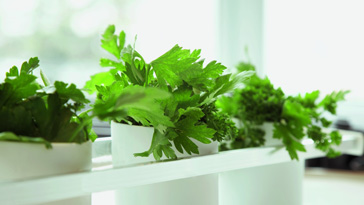
Whether fish, meat or poultry - parsley adds a fresh, hearty note to every dish. The aromatic leaves of the parsley are ever present in cuisine; almost every dish can be seasoned or decorated with them, from salad to soup and sauce to egg dishes, vegetable dishes and stews. Finely chopped in fresh cheese or curd with a little salt, parsley will make for a savoury dip. When cooked with stocks or vegetable soups, the stems add flavour. Parsley loses its flavour when dried, therefore wrap it loosely in moist paper towels and keep in the refrigerator or chop and freeze in ice cube trays.
-
Peppermint (Mentha x piperita)
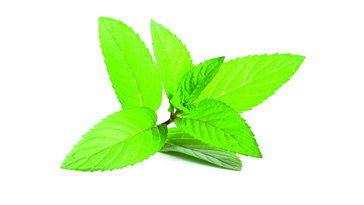
With its refreshing aromatic flavour, peppermint is a superb companion for sauces, salads, vegetable and lamb dishes, as well as numerous sweet dishes. As many plants from the mint family, genuine peppermint is rich in essential oils - therefore use sparingly. Strawberries, fruit salad, ice cream, sorbet and granité receive a special twist through the addition of fresh, finely cut leaves. Peppermint harmonises perfectly with peas and potatoes, enriches the flavour of field greens and adds a refreshing note to poultry dishes, especially if they contain fruits. Tea tastes best when made from fresh leaves. If you want to dry the leaves, it should be done before the plant blooms, as they contain an especially large amount of cooling menthol at that time.
-
Pimento (Pimenta dioica)
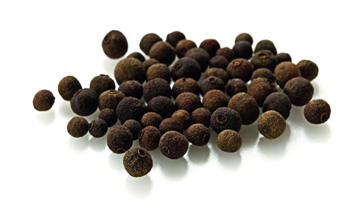
Also known as allspice or Jamaican pepper. The Caribbean island has been one of its primary growing regions until today. There, the fresh leaves of the shrub are used in addition to the berries. Pimento was favoured already by the Aztecs, primarily for adding flavour their cocoa beverages. At the beginning of the 16th century, the valuable grains found their way from South America to Europe and have refined the taste of hearty casseroles, stews and roasts ever since. The bittersweet, spicy taste reminds of cloves and unfolds its tantalising flavour particularly in printes [Christmas cookies] and lebkuchen [gingerbread]. Pimento should be stored in a dry environment protected from light. It is best to purchase the whole berries. They keep for several months and unfold their marvellous peppery scent when fleshly ground.
-
-
R
-
Rosemary (Rosmarinus officinalis)
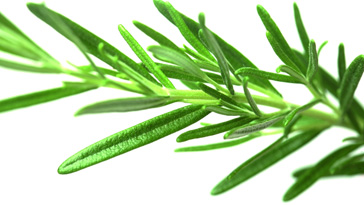
A typical Mediterranean spice, rosemary today has made its home in almost all kitchens worldwide. Even the Romans seasoned their meat dishes with the leaves of the evergreen shrub. The tender tips of the branches and the needle-like leaves are very aromatic, somewhat bitter, are reminiscent of eucalyptus and have a stimulating effect. Fresh rosemary blends well with Mediterranean dishes - lamb, poultry, pork roast, fish, vegetable soups, fresh, grilled or marinated sheep or goat's cheese and bread. Grilled dishes, whether meat, fish, vegetables or potatoes, are given an unmistakable, tantalising note by adding fresh rosemary. Always use rosemary fresh, it loses its flavour quickly when dried.
-
-
S
-
Saffron (Crocus sativus)
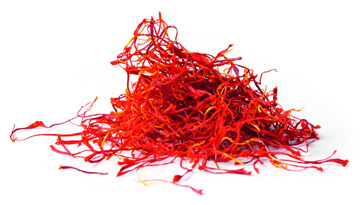
Since the stigmas of the saffron crocus can only be picked individually by hand, saffron is the most expensive spice worldwide. Based on residual moisture, 100 000 to 200 000 blossoms are needed to produce one orange-yellow kilogramme - one picker can pick about 60 to 80 grams per day. In the kitchen, saffron serves as a colouring agent as well as a seasoning for cakes and soups, sauces for fish and shellfish, risotto and paella, whereby only the yellow crocin contained in it is water soluble, not the brick red carotin. Saffron should be used very sparingly, because too much will result in spicy bitterness. Saffron substitues include safflower, dandelions or marigolds, however, they have no taste and only add yellow colour to the dish. Ground saffron should be avoided, as it is only evident if the saffron is genuine during its use.
-
Sage (Salvia officinalis)
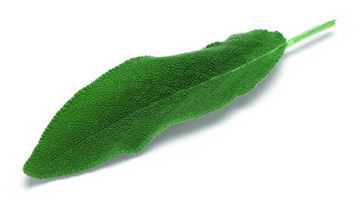
Whether fresh or dried, sage should always be used sparingly, only then will it compliment the inherent taste of fish, meat and poultry. The fresh leaves contain many essential oils and taste refreshing, slightly bitter and spicy, with a touch of menthol. They add flavour to egg dishes, sausages, roasted poultry, pork, veal and lamb, light soups and sauces, but are also well suited as a filling for baked fish. Dried sage has a very intense minty and metallic taste and therefore should be used sparingly as well. The blue to violet blossoms make a nice garnish but do not taste particularly good. Fresh sage can be kept in the refrigerator wrapped loosely in a moist paper towel or can be chopped and frozen an the ice cube tray.
-
Star Anise (Illicium verum)
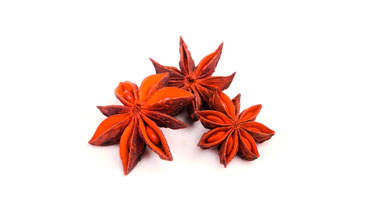
Star anise is the ripe, dried fruit of an evergreen tree that grows in tropical climates. The star-shaped fruit with eight or nine points tastes similar to anise, sweet like liquorice, but also a little peppery and tart. As the peel is more flavourful than the seeds, star anise is used or ground in its entirety. Star anise is an important component of the Chinese five spice powder as well as curry mixtures and Christmas spices.
-
Summer Savoury (Satureja hortensis)
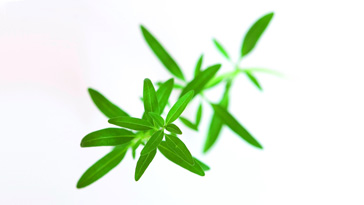
Summer savoury can be found in the Mediterranean region as well as in India, South Africa and North America. It owes its bitter-aromatic taste with a slight scent of thyme to the numerous bitter substances that are also good for digestion. The peppery taste of the fresh or dried leaves and shoots goes well with pulses, lamb and potato dishes, stews, mutton and fatty meat, as well as salads - in small amounts. As this annual (summer) savoury has a very intense taste, it should be used sparingly and only added to dishes at the end. In the garden this unassuming savoury likes sunny, warm spots, and light, permeable soil. It is harvested from June to September.
-
-
T
-
Tamarind (Tamarindus indica)
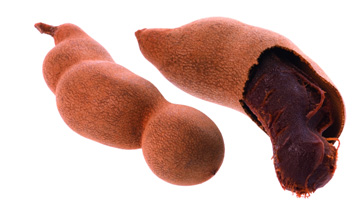
Tamarind, also called Indian date or sour date, is the legume of the tamarind tree. Tamarind is available in two flavour orientations: Sweet tamarind has a brownish pulp, tart-sourly tamarind has an almost black pulp that reminds of raisins with its consistency and colour. Tamarind is an essential component of condiments such as Worcester and barbecue sauces. Tamarind syrup serves as a basis for refreshing beverages and sorbets, jams and hard candy.
-
Tarragon (Artemisia dracunculus)
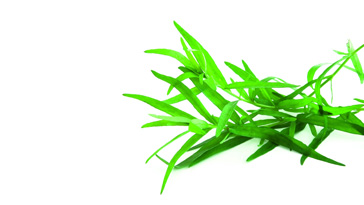
Tarragon is typically used for seasoning soups and sauces but can also be found in pickled cucumbers, salads and some varieties of mustard.
-
Thyme (Thymus vulgaris)
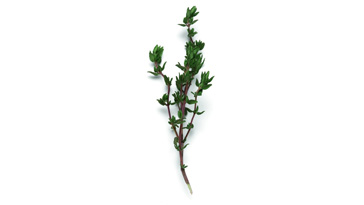
As a true child of the Mediterranean region, thyme is spoilt by the sun and is an excellent complement to meat, chicken and pasta. The tiny evergreen leaves and tender shoots of thyme have a very aromatic, tart and slightly smoky taste. In France, thyme is a component of the herb mixture Herbes de Provence. Thyme is well suited for meat, poultry and vegetable dishes, and (together with honey) adds flavour to fresh sheep's and goat cheese as well as sweets. The blossoms can be used for garnish but may also be eaten. Several hundred varieties of thyme are known, which all have a very different taste - their flavours reach from pineapple to lemon.
-
Turmeric (Curcuma longa)
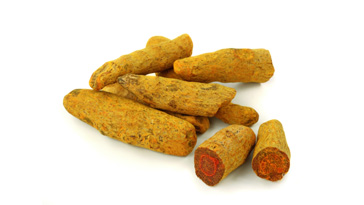
The root stocks with their bright orange-yellow insides grow in the tropical regions of India and Southeast Asia and are also known as yellow root or Indian saffron. Turmeric is an essential component of all curry mixtures, either fresh or dried and ground. Its pungent, slightly tangy and refreshing flavour is well suited for light meat, poultry and fish, salad sauces, pickled vegetables and seasoning mixtures for grilling. Turmeric should be stored in a dry place and not for too long, as it loses flavour quickly and the colour fades when exposed to light.
-
-
V
-
Vanilla (Vanilla planifolia)
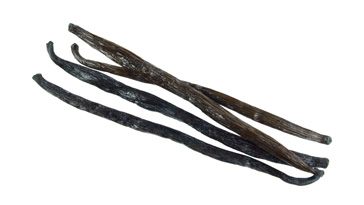
Vanilla is the second most expensive spice worldwide after saffron. It is obtained from the fermented capsules of diverse types of vanilla species. Most of the flavour is contained in the capsule hull and not in the black vanilla pulp with the small seeds contained in it. Therefore, the pods should always be included when cooking. Vanilla adds flavour to almost every sweet dish, but also to light sauces that accompany fish and seafood.
-
-
W
-
Wild Garlic (Allium ursinum)
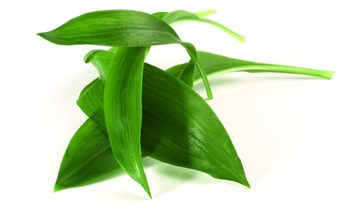
After spending many years in the shadow of its cultivated brother, the garlic, wild garlic has found its entrance into the star gastronomy during the past several years. The plants grow up to 35 cm tall and have been growing along the beds of streams and in the deciduous forests of western and middle Europe for thousands of years. The leaves, flower buds and blossoms can be harvested from March to June depending on the weather, the bulbs however only after the plants have blossomed. Wild garlic should always be used fresh. Its taste is reminiscent of of mild garlic as well as hearty chives. Used sparingly, wild garlic fits well with soups, salads and vegetables in raw or sauteed form. It can also be marinated in oil or vinegar and processed to make pesto.
-